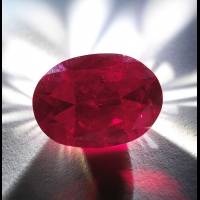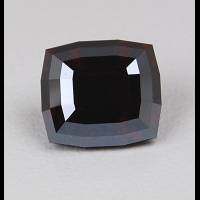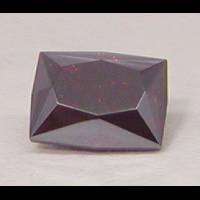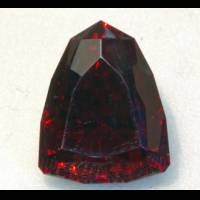Cuprite

Namibia
35.31 carats
© Mineral Classics
Cuprite forms well-developed cubic crystals. It shows internal reflections of the deep garnet-red colour inside the almost black crystal. Cuprite has metallic luster and very high refractive index. Cuprite produces attractive cabochons and fine faceted stones, but it is very soft and brittle.
There are different types of stone which are dyed red and offered in the trade as cuprite.
Cuprite Gemstones by Colour
This table shows the variety of hues this gemstone can be found in. Click on a photo for more information.
Cuprite Gemstones by Size
This table shows distribution of Cuprite gemstone sizes that are listed on this site. This can give a good indication as to the general availability of this gemstone in different sizes.
Contributed photos
Lightest:0.24 cts
Heaviest:66.34 cts
Average:13.92 cts
Total photos:14
Do you have a larger Cuprite? Why not upload a photo?
| General Information | ||||||||||||||||||||||||||
|---|---|---|---|---|---|---|---|---|---|---|---|---|---|---|---|---|---|---|---|---|---|---|---|---|---|---|
| Chemical Formula |
| |||||||||||||||||||||||||
| Physical Properties of Cuprite | ||||||||||||||||||||||||||
| Mohs Hardness | 3.5 to 4, Blue Chart Gem Identification (2010) More from other references | |||||||||||||||||||||||||
| Specific Gravity | 5.85 to 6.15, Blue Chart Gem Identification (2010) More from other references | |||||||||||||||||||||||||
| Cleavage Quality | Distinct, Gemmological Tables (2004) More from other references | |||||||||||||||||||||||||
| Fracture | Uneven, Gemstones (2009) | |||||||||||||||||||||||||
| Heat Sensitivity | Sensitive to heat, Blue Chart Gem Identification (2010) | |||||||||||||||||||||||||
| Optical Properties of Cuprite | ||||||||||||||||||||||||||
| Refractive Index | 2.849, Blue Chart Gem Identification (2010) More from other references | |||||||||||||||||||||||||
| Optical Character | Isotropic, Gemmological Tables (2004) More from other references | |||||||||||||||||||||||||
| Dispersion | Nil, Gemstones (2009) | |||||||||||||||||||||||||
| Colour | ||||||||||||||||||||||||||
| Colour (General) | Carmine-red, Gemstones of the world (2001) More from other references | |||||||||||||||||||||||||
| Causes of Colour | Red, Band theory, Pragmatic Spectroscopy For Gemologists (2011) | |||||||||||||||||||||||||
| Transparency | Translucent, Gemstones of the world (2001) More from other references | |||||||||||||||||||||||||
| Lustre | Metallic, Gemstones of the world (2001) More from other references | |||||||||||||||||||||||||
| Crystallography of Cuprite | ||||||||||||||||||||||||||
| Crystal System | Isometric, Blue Chart Gem Identification (2010) More from other references | |||||||||||||||||||||||||
| Habit | Cubes, octahedra or combinations of forms, Gems, Sixth Edition (2006) More from other references | |||||||||||||||||||||||||
| Geological Environment | ||||||||||||||||||||||||||
| Where found: | Occurs in the oxidized zones of copper deposits, Gems, Sixth Edition (2006) | |||||||||||||||||||||||||
| Further Information | ||||||||||||||||||||||||||
| Mineral information: | Cuprite information at mindat.org | |||||||||||||||||||||||||
| Significant Gem Localities | ||||||||||||||||||||||||||
| ||||||||||||||||||||||||||











